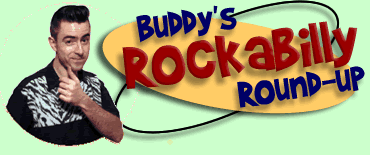



Before the arrival of rockabilly music in 1954, both country music and blues were the most popular genres throughout the US. Rockabilly owes a lot to both white country & western and black rhythm & blues, but it essentially represents a new and exciting kind of youth culture.
COUNTRY MUSIC
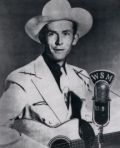 |
During the 1940s country music appealed to an increasingly wide audience thanks to live radio shows such as the Louisiana Hayride and the Grand Ole Opry, which brought the likes of Bill Monroe and Hank Williams to national stardom. There were 4 main categories in country music: western swing, hillbilly boogie, honky tonk and bluegrass. Each one had a significant influence on rockabilly. |
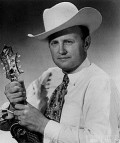 |
1.Western
Swing
Western swing developed in Texas and Oklahoma in the 1930s as a countrified
form of big-band swing jazz (Benny Goodman and Tommy Dorsey). It also shows
elements of traditional fiddle tunes, East European (Czech & Polish) polkas
& waltzes and Tex-Mex. The founding fathers of western swing were Milton
Brown (°Texas 1903, +1936 in a car crash) and 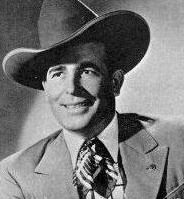 Bob
Wills (°Texas 1905, +1975). Especially fiddle player and band leader
Bob Wills, backed by his Texas Playboys, popularized western swing. First recording
in 1935 for ARC (later incorporated in Columbia Records), they produced cheerful
classics such as "Steel Guitar Rag", "New San Antonio Rose",
"Roly Poly" , "Take Me Back To Tulsa" and "Stay A Little
Longer".
Bob
Wills (°Texas 1905, +1975). Especially fiddle player and band leader
Bob Wills, backed by his Texas Playboys, popularized western swing. First recording
in 1935 for ARC (later incorporated in Columbia Records), they produced cheerful
classics such as "Steel Guitar Rag", "New San Antonio Rose",
"Roly Poly" , "Take Me Back To Tulsa" and "Stay A Little
Longer".
Other important band leaders include Tex Williams, Spade Cooley, Hank Penny,
PeeWee King and Hank Thompson.
Not surprisingly, the high-geared excitement and electrified energy of western
swing had a considerable impact on rockabilly.
2.Hillbilly
Boogie
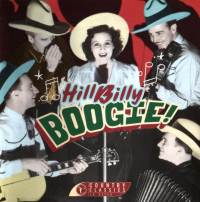 This
type ofgood-natured hillbilly music with a boogie beat emerged in the late 1930s
and early 1940s. The beat and the vocal parts sound relaxed and restrained,
which suggests a strong influence of the blues.
This
type ofgood-natured hillbilly music with a boogie beat emerged in the late 1930s
and early 1940s. The beat and the vocal parts sound relaxed and restrained,
which suggests a strong influence of the blues.
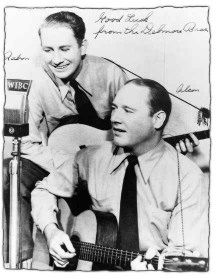 The
Delmore Brothers, from Alabama, scored hits with "Freight Train Boogie"
(1946), "Blues Stay Away From Me" (covered by Johnny Burnette, Gene
Vincent, Wanda Jackson …) and "Pan American Boogie" (1949) on
the Cincinnati-based King label.
The
Delmore Brothers, from Alabama, scored hits with "Freight Train Boogie"
(1946), "Blues Stay Away From Me" (covered by Johnny Burnette, Gene
Vincent, Wanda Jackson …) and "Pan American Boogie" (1949) on
the Cincinnati-based King label.
During the late 1940s they recorded gospel music with Granpa Jones and Merle
Travis as the Brown's Ferry Four.
Tennessee Ernie Ford sang his way to stardom with "Shotgun Boogie"
in 1950, later covered by Johnny Horton and Jesse Lee Turner, "Blackberry
Boogie", "Mule Train" and Merle Travis's "Sixteen Tons"
in 1955.
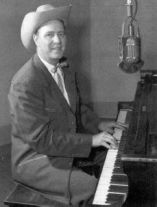 Moon
Mullican, the King of the Hillbilly Piano Players and considered a major
influence on Jerry Lee Lewis, was strongly influenced by black boogie-woogie
artists such as Pinetop Smith and Albert Ammons. He recorded "Pipeliner
Blues" in 1945, "New Jole Blon" in 1947 and "I'll Sail My
Ship Alone" and "Cherokee Boogie" in 1950.
Moon
Mullican, the King of the Hillbilly Piano Players and considered a major
influence on Jerry Lee Lewis, was strongly influenced by black boogie-woogie
artists such as Pinetop Smith and Albert Ammons. He recorded "Pipeliner
Blues" in 1945, "New Jole Blon" in 1947 and "I'll Sail My
Ship Alone" and "Cherokee Boogie" in 1950.
Merle Travis, a legendary guitar wizard born in Muhlenberg County (Kentucky)
in 1917, established the fingerpicking style in country music. Chet Atkins,
Doc Watson, Scotty Moore and Carl Perkins all learned to imitate his guitar
style.Merle Travis wrote such classics as "Merle's Boogie Woogie",
"Smoke Smoke Smoke That Cigarette" and "Sixteen Tons" (all
in 1947). He sadly died in 1983.
The colorful Maddox Brothers & Rose started performing in California in
1937, with singer Rose Maddox only 11 years old. They became one of the most
popular West Coast hillbilly bands, recording joyful songs such as "Alimony",
"Mean & Wicked Boogie", "Hey Little Dreamboat" and "Ugly
& Slouchy". They broke up in 1957 but Rose started a solo career, scoring
country hits with "Mental Cruelty" and "Loose Talk" with
Buck Owens in 1961.
3.Honky
Tonk
Honky-tonk music is essentially big-town music with a rural hillbilly background.
Played in small and noisy honky-tonk bars, it implies the need for small combos
and electrified instruments (electric guitar, steel guitar, fiddle, double bass
and drums). The up-tempo dance songs deal with "dancin', drinkin' and fightin'"
and the slow songs with "lost love and trouble times".
Ernest Tubb (°Texas 1914,+Nashville 1984) carved out the honky-tonk genre
with "Walkin' The Floor Over You" (1941) and "You Nearly Lose
Your Mind" (1942), which was covered in pure rockabilly style by Roy Moss
(in 1956) and later, in 1983, by the Memphis Rockabilly Band on the French Big
Beat label. Tubb was the first musician to use an electric guitar on the Grand
Ole Opry in 1943.
Hank Williams, Ted Daffan ("Born To Lose"), Lefty Frizzell ("If
You've Got The Money, I've Got The Time" 1950, "Always Late"
1951 and "Long Black Veil" 1959) and Webb Pierce ("Honky Tonk
Song" and the rockabilly-styled "Teenage Boogie") all played
an essential part in the evolution of honky-tonk music.
Canadian Hank Snow scored hits with "I'm Movin' On", "The Golden
Rocket" and "The Rhumba Boogie" in the early '50s. Later hits
included "The Gold Rush Is Over", "The Gal Who Invented Kissin'"
and "I've Been Everywhere" (1962).
Faron Young, from Louisiana, recorded a number of great honky-tonk songs like
"Goin' Steady" (1953), "If You Ain't Lovin', You Ain't Livin'",
"Live Fast, Love Hard, Die Young", "I've Got Five Dollars &
It's Saturday Night" and "Alone With You".
George Jones recorded some rockabilly-styled songs such as "Who Shot Sam",
"How Come It", "Rock It", "Maybe Little Baby",
"Why Baby Why" and "White Lightning" under his pseudonym
Thumper Jones. During the 1960s he recorded "The Race Is On", "Burn
The Honky Tonk Down", "Feeling Single, Seeing Double" and "Milwaukee
Here I Come".
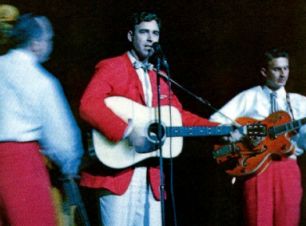 Johnny
Horton joined the Louisiana Hayride radio show in the early 1950s. He first
recorded for Abbott and Mercury Records, but in 1956 he signed with Columbia,
scoring a big hit with "Honky Tonk Man". He recorded great songs like
"I'm Comin' Home", "I'm A One-Woman Man" (both 1956), "Honky
Tonk Hardwood Floor" , "Let's Take The Long Way Home" (both 1957),
"The Wild One" (1958), "The First Train Headin' South" and
"Got The Bull By The Horns" (both 1959). He subsequently recorded
folk-style ballads like "North To Alaska", "The Battle Of New
Orleans", "Sink The Bismarck", "The Sinking Of The Reuben
James" and "O'Leary's Cow". His career was tragically ended in
1960 when he was killed in a car accident after falling asleep at the wheel.
Ironically his last (posthumous) hit was "Sleepy-Eyed John".
Johnny
Horton joined the Louisiana Hayride radio show in the early 1950s. He first
recorded for Abbott and Mercury Records, but in 1956 he signed with Columbia,
scoring a big hit with "Honky Tonk Man". He recorded great songs like
"I'm Comin' Home", "I'm A One-Woman Man" (both 1956), "Honky
Tonk Hardwood Floor" , "Let's Take The Long Way Home" (both 1957),
"The Wild One" (1958), "The First Train Headin' South" and
"Got The Bull By The Horns" (both 1959). He subsequently recorded
folk-style ballads like "North To Alaska", "The Battle Of New
Orleans", "Sink The Bismarck", "The Sinking Of The Reuben
James" and "O'Leary's Cow". His career was tragically ended in
1960 when he was killed in a car accident after falling asleep at the wheel.
Ironically his last (posthumous) hit was "Sleepy-Eyed John".
4.Bluegrass
Bluegrass emerged in Kentucky in the early 1940s. The bluegrass repertorium
mainly consists of lightning-fast instrumental breakdowns, soulful gospels,
traditional ballads and blues themes. Since bluegrass is a traditional and rigorous
genre, electric instruments are considered inconvenient; the standard bluegrass
instruments are banjo, mandolin, fiddle, acoustic guitar and double bass. Another
typical aspect of bluegrass is the high-pitched tenor singing.
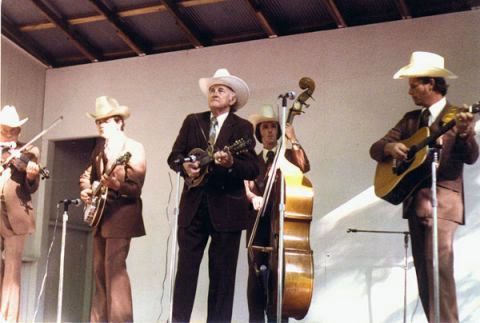 |
Bill
Monroe, the Father of Bluegrass Music, paved the way for others to follow.
Bill Monroe & The Blue Grass Boys recorded classics such as "Rocky
Road Blues" (rockabilly versions by Gene Vincent and Ronnie Self), "Muleskinner
Blues", "Blue Moon Of Kentucky" (originally in waltz time) and
"Little Cabin Home On The Hill" (both covered by Elvis).
Other influential bluegrass artists include Lester Flatt & Earl Scruggs,
The Stanley Brothers, Don Reno & Red Smiley, Jim & Jesse, Jimmy Martin
and The Kentucky Colonels.
BLUES
After World War II more and more blues music (especially rhythm & blues)
was broadcast over the radio, so inevitably black music also became popular
with white listeners. The most popular styles were Chicago blues (Muddy Waters,
Little Walter and Howlin' Wolf), boogie woogie (Jimmy Yancey, Meade Lux Lewis
and Albert Ammons) and jump blues.
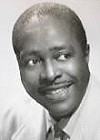 Jump
blues developed in the 1940s, especially thanks to the original and humorous
compositions ofLouis Jordan. He was the link between big-band swing and
rhythm & blues. He scored more than 50 major hits, such as "Knock Me
A Kiss", "Caldonia", "Five Guys Named Moe", "Is
You Is Or Is You Ain't", "Choo Choo Ch-Boogie", "Ain't Nobody
Here But Us Chickens", "Let The Good Times Roll", "Jack,
You're Dead", "Saturday Night Fish Fry" and "Open The Door,
Richard". Louis Jordan influenced rhythm & blues vocalists such as
Roy Brown, Wynonie Harris and Roy Milton and early rock & roll artists like
Bill Haley and Chuck Berry.
Jump
blues developed in the 1940s, especially thanks to the original and humorous
compositions ofLouis Jordan. He was the link between big-band swing and
rhythm & blues. He scored more than 50 major hits, such as "Knock Me
A Kiss", "Caldonia", "Five Guys Named Moe", "Is
You Is Or Is You Ain't", "Choo Choo Ch-Boogie", "Ain't Nobody
Here But Us Chickens", "Let The Good Times Roll", "Jack,
You're Dead", "Saturday Night Fish Fry" and "Open The Door,
Richard". Louis Jordan influenced rhythm & blues vocalists such as
Roy Brown, Wynonie Harris and Roy Milton and early rock & roll artists like
Bill Haley and Chuck Berry.
Rockabillies particularly enjoyed fast and wild rhythm & blues bands, which
consisted of guitars, sax, piano, bass and drums. A lot of rockabilly artists
tried to imitate the fast-paced frantic stage shows of rhythm & blues groups.
The influence of black music on white performers was not something new, as also
pre-rockabilly country singers like Moon Mullican and Hank Williams adopted
elements of the blues.
Let's take a closer look now at two essential predecessors of rockabilly: Hank Williams and Bill Haley.
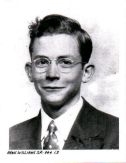 Hank
Williams was one of the most influential country artists of all times. He
was born in Alabama in 1923 and was strongly influenced by Roy Acuff, Ernest
Tubb and a black street singer named Rufus "Tee-Tot" Payne. Hank also
liked gospel singing and cajun music. In 1937 he formed the first version of
his band, The Drifting Cowboys. "Move It On Over", a huge hit recorded
for MGM in 1947, was the perfect prelude to rockabilly. With Chubby Wise (fiddle),
Jerry Byrd (steel guitar), Zeke Turner (lead guitar) and Owen Bradley (piano)
he recorded "Honky Tonkin'", "I'm A Long Gone Daddy", "Pan
American", "The Blues Come Around", the gospel-inspired "I
Saw The Light" and Fred Rose's "Rootie Tootie".
Hank
Williams was one of the most influential country artists of all times. He
was born in Alabama in 1923 and was strongly influenced by Roy Acuff, Ernest
Tubb and a black street singer named Rufus "Tee-Tot" Payne. Hank also
liked gospel singing and cajun music. In 1937 he formed the first version of
his band, The Drifting Cowboys. "Move It On Over", a huge hit recorded
for MGM in 1947, was the perfect prelude to rockabilly. With Chubby Wise (fiddle),
Jerry Byrd (steel guitar), Zeke Turner (lead guitar) and Owen Bradley (piano)
he recorded "Honky Tonkin'", "I'm A Long Gone Daddy", "Pan
American", "The Blues Come Around", the gospel-inspired "I
Saw The Light" and Fred Rose's "Rootie Tootie".
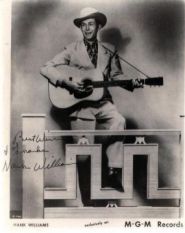 Hank's compositions
"Mind Your Own Business", "I Just Don't Like This Kind Of Living",
"My Bucket's Got A Hole In It", "Kawliga", "Settin'
The Woods On Fire", "Hey Good Lookin'", "Fool About You",
"Long Gone Lonesome Blues" and "Why Don't You Love Me (Like You
Used To Do)" have all been covered by rockabillies.
Hank's compositions
"Mind Your Own Business", "I Just Don't Like This Kind Of Living",
"My Bucket's Got A Hole In It", "Kawliga", "Settin'
The Woods On Fire", "Hey Good Lookin'", "Fool About You",
"Long Gone Lonesome Blues" and "Why Don't You Love Me (Like You
Used To Do)" have all been covered by rockabillies.
Hank Williams was a marvelous showman with a deeply emotional style, but he
was also known for heavy drinking and violent behavior. He died in West Virginia
on New Year's Day, 1953 at the age of 29, while being driven at a show in Canton,
Ohio.
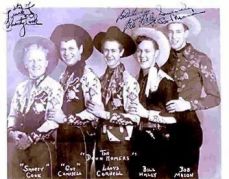 Bill
Haley, born in Michigan in 1925, grew up in Philadelphia, where he formed his
hillbilly band Bill Haley & The Saddlemen in 1949 (after playing with The
Downhomers and
Bill
Haley, born in Michigan in 1925, grew up in Philadelphia, where he formed his
hillbilly band Bill Haley & The Saddlemen in 1949 (after playing with The
Downhomers and 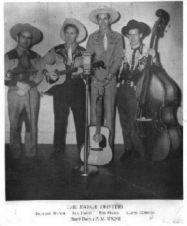 The
Range Drifters) and recorded country & western tunes like "Ten
Gallon Stetson", "The Covered Wagon Rolled Right Along", "Cold,
Cold Heart" and Roy Acuff's "Wreck On The Highway". Bill Haley
also enjoyed listening to black rhythm & blues, especially Big Joe Turner
and Louis Jordan. In 1951 Bill recorded Jackie Brenston's "Rocket 88",
a nice example of early rock & roll. In 1952 Bill Haley & The Saddlemen
covered Jimmy Preston's 1949 rhythm & blues hit "Rock The Joint",
which already hinted at rockabilly.
The
Range Drifters) and recorded country & western tunes like "Ten
Gallon Stetson", "The Covered Wagon Rolled Right Along", "Cold,
Cold Heart" and Roy Acuff's "Wreck On The Highway". Bill Haley
also enjoyed listening to black rhythm & blues, especially Big Joe Turner
and Louis Jordan. In 1951 Bill recorded Jackie Brenston's "Rocket 88",
a nice example of early rock & roll. In 1952 Bill Haley & The Saddlemen
covered Jimmy Preston's 1949 rhythm & blues hit "Rock The Joint",
which already hinted at rockabilly.
In 1953 they changed their name to Bill Haley & The Comets and the band's
outfit changed from cowboy to tuxedos. They decided to add a tenor sax, a typical
rhythm & blues instrument and they recorded best-selling rock & roll
songs such as "Crazy Man Crazy", "Shake Rattle & Roll"
(inspired by Big Joe Turner's version) and "Rock Around The Clock"
(1954). "Skinny Minnie", a Bo Diddley-inspired tune from 1958, was
his last hit record.
Bill Haley & The Comets introduced hot-fired guitar solos (Franny Beecher),
dynamic slappin' bass lines (Marshall Lytle) and solid dance beats. Singer Bill
Haley was the perfect combination of blues and country, but he lacked the rebellious
spontaneity of rockabilly.
Saxophonist Rudy Pompilli died in 1976. Bill Haley died of a heart attack in
Harlingen, Texas in 1981.
Buddy
The Kid